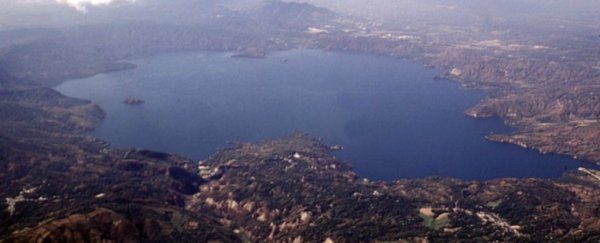Researchers from the UK have found evidence that a pool of magma is building up 6 kilometres (3.7 miles) beneath San Salvador's Ilopango caldera.
The evidence suggests that the capital city of El Salvador might be at risk for a future volcanic eruption.
Besides offering a possible warning for those living in El Salvador, the findings also shed new light on how magma pools along tectonic fault lines, providing a better way to predict future eruptions that might put communities at risk.
"Our results indicate that localised extension along the fault zone controls the accumulation, ascent, and eruption of magma at Ilopango," team member Joachim Gottsmann from the University of Bristol said in a statement.
"This fault-controlled magma accumulation and movement limits potential vent locations for future eruptions at the caldera in its central, western and northern part – an area that now forms part of the metropolitan area of San Salvador, which is home to 2 million people," he continued.
"As a consequence, there is a significant level of risk to San Salvador from future eruptions of Ilopango."
While the caldera – an 11-kilometre (6.8-mile) wide volcanic crater that forms when the top of a volcano collapses after a major eruption – has had at least five major eruptions in the last 80,000 years, the last major one happened almost 1,500 years ago.
Since then, eruptions – such as the most recent one, which took place back in the late-1800s – have been small.
Now, the UK team says that the Ilopango caldera is getting ready to erupt again, though they do not go into detail as to when that eruption might occur.
The team came to their conclusion after studying the 'density distribution' beneath the Ilopango caldera to see how shifting of tectonic plates might cause magma to build up and – when enough is there – cause a volcanic eruption.
"Most earthquakes take place along the edges of tectonic plates, where many volcanoes are also located," Gottsmann said.
"There is therefore a link between the breaking of rocks, which causes faults and earthquakes and the movement of magma from depth to the surface, to feed a volcanic eruption. The link between large tectonic fault zones and volcanism is, however, not very well understood."
This is important because – up until now – researchers haven't had any substantial data on how fault lines feed volcanoes despite the fact that many researchers agree on the link.
"Addressing this question is important not only for understanding controls on the development of magmatic systems, but also for forecasting probable locations of future eruptive activity from caldera-forming volcanoes," team member Jennifer Saxby said.
For people living in areas ripe with geological activity, such as those in El Salvador along the Central American Volcanic Arc (CAVA) or the San Andreas Fault in the US, the team's findings will hopefully offer a better understanding of how volcanoes build up and eventually erupt.
The team's findings aren't the only new insights researchers have gained about volcanoes recently, either.
Earlier this month, researchers from the US found that the gravitational pull of the Sun and Moon can cause earthquakes along the San Andreas fault, linking geological activity to tidal forces.
Back in June, a team from Germany discovered the forces at work behind volcanic lightning.
The new study has recently been published in the journal Nature Communications.
